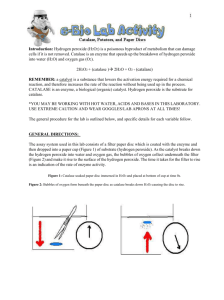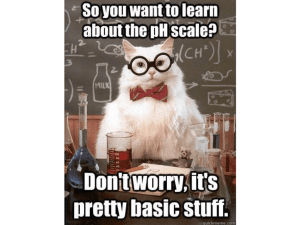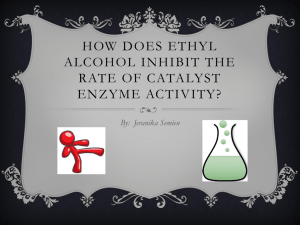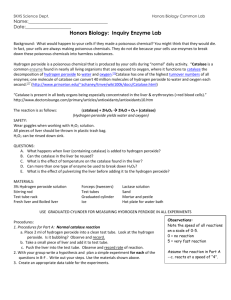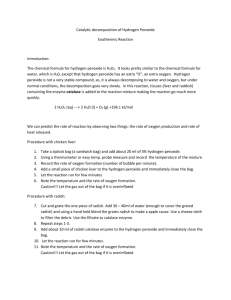Science Research Investigation
advertisement
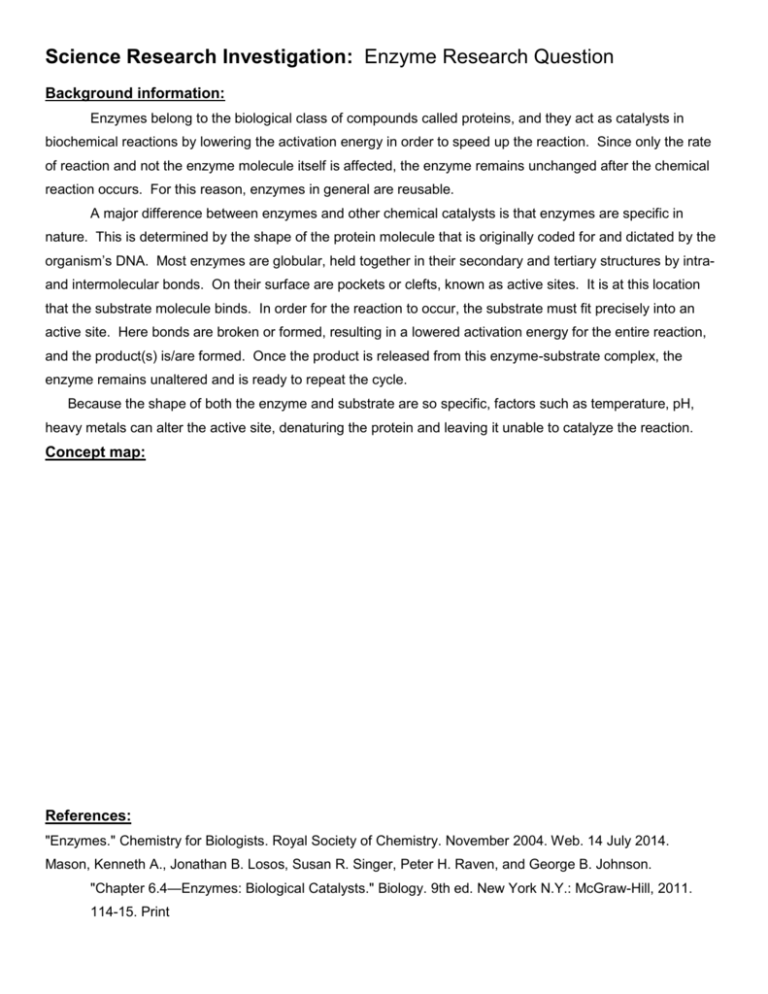
Science Research Investigation: Enzyme Research Question Background information: Enzymes belong to the biological class of compounds called proteins, and they act as catalysts in biochemical reactions by lowering the activation energy in order to speed up the reaction. Since only the rate of reaction and not the enzyme molecule itself is affected, the enzyme remains unchanged after the chemical reaction occurs. For this reason, enzymes in general are reusable. A major difference between enzymes and other chemical catalysts is that enzymes are specific in nature. This is determined by the shape of the protein molecule that is originally coded for and dictated by the organism’s DNA. Most enzymes are globular, held together in their secondary and tertiary structures by intraand intermolecular bonds. On their surface are pockets or clefts, known as active sites. It is at this location that the substrate molecule binds. In order for the reaction to occur, the substrate must fit precisely into an active site. Here bonds are broken or formed, resulting in a lowered activation energy for the entire reaction, and the product(s) is/are formed. Once the product is released from this enzyme-substrate complex, the enzyme remains unaltered and is ready to repeat the cycle. Because the shape of both the enzyme and substrate are so specific, factors such as temperature, pH, heavy metals can alter the active site, denaturing the protein and leaving it unable to catalyze the reaction. Concept map: References: "Enzymes." Chemistry for Biologists. Royal Society of Chemistry. November 2004. Web. 14 July 2014. Mason, Kenneth A., Jonathan B. Losos, Susan R. Singer, Peter H. Raven, and George B. Johnson. "Chapter 6.4—Enzymes: Biological Catalysts." Biology. 9th ed. New York N.Y.: McGraw-Hill, 2011. 114-15. Print Teacher Guidelines Science Research Investigation: Enzyme Research Question Preparation of the solutions: Figure 1: Materials need for making the two enzyme solutions Liver Solution: Mass approximately 35 grams of beef or chicken liver on an electronic scale. Place the liver into a blender. Add enough distilled water to bring the level of the liver and water solution to one liter. Blend thoroughly. Strain the solution through a mesh strainer into a 1-L Erlenmeyer flask and label as “Liver Solution.” Potato Solution: Mass approximately 35 grams of a peeled, raw potato on an electronic scale. Place the potato into a blender. Add enough distilled water to bring the level of the potato and water solution to one liter. Blend thoroughly. Strain the solution through a mesh strainer into a 1-L Erlenmeyer flask and label as “Potato Solution.” Hydrogen Peroxide Solution: Obtain 500 mL of 3% hydrogen peroxide and dilute it by adding 500 mL of distilled water. Place solution in a third 1-L Erlenmeyer flask or beaker and label as “1.5% Hydrogen Peroxide.” Figure 2: Straining the solution Teacher Hints: 1. The denaturing of catalase in the potato solution can be slowed by placing the solution in an ice bath. The best way to solve this problem is to prepare the potato solution catalase a day or two in advance and pour it into ice cube trays. Place one cube in a small beaker for each group. By the time the group finishes with setting up the experiment the cube containing catalase has melted. You may want to warn them that the potato solution takes a few seconds to get started. 2. Students should run two or three trials for each solution to become comfortable with the apparatus. 3. The minimum number of students in each group should be three, with one holding the inverted graduated cylinder with the tubing inside of it, one mixing the solutions and swirling the Erlenmeyer flask/tubing apparatus, and another to time the reaction by watching for the first and final oxygen bubbles. The reaction will slow down, so the observation of the final bubble will be approximate. As long as each group is consistent in the collection of the data, the rates should be similar. 4. As an extension to this initial activity, students can either be divided into groups or select from the following suggestions to investigate the effect of each of these variables on enzyme activity: a. Double the enzyme volume b. Halve the enzyme volume c. Double the substrate volume d. Halve the substrate volume e. Determine the effect of acid and base f. Change the temperature of the enzyme Figure 3: Label the solutions Figure 4: Materials for each station Name: _____________________________________________________ Date: ___________ Block: _______ Science Research Investigation: Do plants differ in catalase activity compared to animals? Introduction to Enzymes: What would happen to your cells if they made a poisonous chemical? Do you think that your cells would die? In fact, your cells are always making poisonous chemical. They do not die because your cells use enzymes to break down these poisonous chemicals into harmless substances. Enzymes are proteins that speed up the rate of reactions that would otherwise happen more slowly. The enzymes are not altered by the reaction. You have hundreds of different enzymes in each of your cells. Each of these enzymes is responsible for one particular reaction that occurs in the cell. In this lab, you will study an enzyme that is found in the cells of many living tissues. The name of the enzyme is catalase. Catalase speeds up a reaction, which breaks down hydrogen peroxide (a toxic chemical) into water and oxygen. This reaction is important to cells because hydrogen peroxide (H2O2) is produced as a byproduct of many normal cellular reactions. If the cell does not break down the hydrogen peroxide, they would be poisoned and die. The reaction is written as follows: 2H2O2 2H2O + O2 In this lab, you will study the catalase found in liver and potato cells. You will be using chicken or beef liver that your teacher purchased in the supermarket. It might seem strange to use dead tissues to study the function of enzymes. However, is possible because when a cell dies, the enzymes remain intact and active for several weeks, as long as the tissue is kept refrigerated. Adapted from: Towle, Albert. "Catalase Laboratory." Modern Biology. Austin: Holt, Rinehart and Winston, 1989. Print. Prelab Demonstration: What is the purpose of this reaction? A. Measure approximately 5 mL of the hydrogen peroxide into a clean test tube. Is the hydrogen peroxide bubbling? B. Measure 5 mL of liver solution into the other clean test tube. Pour the test tube with the hydrogen peroxide into the test tube holding the liver solution. Notice that this reaction produces bubbles. What gas is being released? C. Recall that a reaction that absorbs heat is endothermic; a reaction that gives off heat is exothermic. Now, feel the temperature of the test tubes with your hand. Has the test tube gotten warmer or cooler? Is the reaction endothermic or exothermic? What do you think is happening in your test tube to cause this reaction to happen? What is this liquid composed of? What do you think would happen if you added more liver solution to this liquid? D. Add another 5 mL of hydrogen peroxide into the test tube holding the liver extract. Clean your station. Can you observe any reaction? What do you think would happen if you added more hydrogen peroxide to the remaining liver solution? Based off your observations, are enzymes reusable? Explain why. 1. Give an overview of the function of an enzyme. Pull in a specific examples of an enzyme (besides catalase) found in the human body and how it functions. 2. Describe the general structure of an enzyme. List and describe the following parts: amino acids, protein folding, substrate, product, and active site. 3. Explain hydrogen peroxide and its role in cell health. How is it produced in the body and explain its purpose and/or lack of purpose. 4. Describe current research that is being done regarding enzymes by using scientific journals, databases and reliable web references. Possible Sources: Chapter 2 Section 4: Enzyme Structure and Function Video Review: http://www.youtube.com/watch?v=XTUm-75-PL4 Science News: http://www.sciencedaily.com/releases/2008/01/080102134129.htm Peer Reviewed: http://www.plosone.org/article/info%3Adoi%2F10.1371%2Fjournal.pone.0007589#s4 Guided Inquiry: Does catalases rate of reaction differ in plants and animals? Materials: - stop watch - tubing - glass dropper tube - stopper - (2) 10 mL graduated cylinder - (1) 100 mL graduated cylinder - (1) 250 mL flask - (1) shallow pan for water bath Enzyme - (3) 250 mL beakers - (2) funnels - Premade solutions of: H2O2, liver, and potato solution Substrate Product(s) Potato Solution Liver Solution Null Hypothesis: There is no significant difference in the rate of reaction (mL/sec) between the catalase found in the potato (plant) and the catalase found in liver (animal). Alternate Hypothesis 1: (If/Then/Because): __________________________________________________ ________________________________________________________________________________________ ________________________________________________________________________________________ Alternate Hypothesis 2: (If/Then/Because): __________________________________________________ ________________________________________________________________________________________ ________________________________________________________________________________________ Procedure: 1. 2. 3. 4. 5. 6. 7. 8. 9. Fill a container 3/4th full of water and submerge a 100 mL graduated cylinder in the water. Measure 10 mL of hydrogen peroxide (diluted with water by 50 percent) in a graduated cylinder. In a second graduated cylinder measure 10 mL of the potato solution. Place the rubber tubing into the submerged graduated cylinder (keeping the mouth of the graduated cylinder under the water) invert the cylinder. Make sure the cylinder is full of water (with limited to no air pockets). Pour the potato solution into the flask and then add the hydrogen peroxide. Quickly place the stopper on the flask and gentle swirl. Begin the timer when the first bubble appears in the cylinder and stop the timer then the bubbles cease. Collect the amount of water displacement (mL) over time (sec) in the chart below. Repeat steps 1 through 7 using the liver solution. Repeat the experiment two times for each solution and share that data with the class. Figure 1: Materials Figure 2: Set up of apparatus Table1: The type of tissues effect on the catalases reaction rate (mL/sec)? Amount of O2 Produced (mL/sec) Trial Catalase found in Potato Catalase found in Liver 1 2 Your Average: Class Average: Line Graph: Include a title; label the x axis and y axis, and make a key that represents the class and your calculated averages using a bar graph. Graph 1: _________________________________________________________________________ Possible Research Questions: Concept Map What variables do you think might be important in the function of this enzyme? Open Inquiry: Come up with YOUR OWN catalase based science research investigation. Assignment: You and your team will design an experiment that investigates one aspect that affects the enzyme catalases activity. You are allowed to work with up to 3 additional individuals to create a research investigation. You may turn in one copy of the materials/procedures per group. Your teacher will meet with each group to quickly to review the materials and procedures and approve your investigation. Remember that you will be responsible for obtaining any materials that are not commonly found in the classroom. Research Question: ________________________________________________________________ ________________________________________________________________________________ Null Hypothesis: _________________________________________________________________________ ________________________________________________________________________________________ ________________________________________________________________________________________ Alternate Hypothesis 1: (If/Then/Because): ____________________________________________________ ________________________________________________________________________________________ ________________________________________________________________________________________ Alternate Hypothesis 2: (If/Then/Because): ____________________________________________________ ________________________________________________________________________________________ ________________________________________________________________________________________ The materials and procedures will be due on: __________________________________ MATERIAL: Your materials list should include the items listed below. - Be very specific - Do NOT number items - Size and number of each item listed - All measurements in METRIC units PROCEDURES: Your procedures should include all of the items listed below. - Numbered steps - Each action should be written as a different step (Do not write in paragraph form). - Write your procedures so that it can be reproduced exactly - Be very specific- include equipment used in that step - Procedure steps include an exact description of how measurements will be taken - Include enough repeat trails (several, one won’t do) - Include diagrams if necessary - No vague statements The data collection will be on: _________________________________________________ Please make sure to bring all the material that you will need that day. It will be the only block of class given to collect the data. The rest will need to be done before or after school based off the teacher availability. Name: ___________________________________________________________________ Date: ______________ Block: _________ Design and conduct your own experiment Research Question: ______________________________________________________________________________ Null Hypothesis: _________________________________________________________________________________ ______________________________________________________________________________________________ Alternate Hypothesis 1 (If/Then/Because): __________________________________________________________________________ ___________________________________________________________________________________________________________ Alternate Hypothesis 2 (If/Then/Because): __________________________________________________________________________ ___________________________________________________________________________________________________________ Independent Variable: How will you manipulate the independent variable in each experimental group? Dependent Variable: Experimental Group 1: What are the constants, controlled variables? Quantify these where possible. Experimental Group 2: Constants: Control Group (if possible): Data Collection Details: In the space below, outline the procedure you will use Dependent Variable: Number of Trials (provide justification): Data Analysis: Another group should be able to replicate it. Include tables, graphs, or both to displace the data necessary to answer your question. Result Guidelines: Including summary of data statistical analysis, tables, and graphs DUE DATE: _________________________________ The results section of your SRP Paper includes the 3 parts listed below: SUMMARY: The Results section is a Summary of the data/statistical tests in paragraph form and should include the following items: Topic Sentence Identification of variables (IV and DV) and control group (If you had one) Whether the data (DV) was qualitative or quantitative, explain why. A description of the statistics performed. o What tests did you do? T-test, ANOVA, or correlation State the null hypothesis and whether it was rejected or failed to be rejected based on the calculated p-value. Example statements: o “The means of the experimental groups were significantly different (P<0.05).” o “There was no statistically significant difference between the means of ____ and _____ (P>0.05).” TABLES: Make a table(s) for your raw data as well as a summary of the statistics done Columns and rows must be straight and neat (typed). Headings (with UNITS) are required on all columns and rows. Titles go above the table, typed in ALL CAPS Example: TABLE 1: PLANT HEIGHT (cm) VERSUS LIGHT EXPOSURE. GRAPHS: Can be either a line graph or a bar graph. Line graphs show trends or relationships. Bar graphs are used for comparison. The independent variable goes on the X-axis; the dependent variable goes on the Y-axis. Label axes with names and units. Include a key. Titles go below the graph, typed in ALL CAPS Example: FIGURE 1: PLANT HEIGHT (cm) VERSUS LIGHT EXPOSURE Discussion Outline: What was the purpose/significance of the experiment? With supporting evidence from your data, explain if your null hypothesis was rejected or failed to be rejected by using your p-value as well as additional descriptive statistics and experimental observations. Example: “The means of the experimental groups were significantly different (P<0.05).” “There was no statistically significant difference between the means of ___ & ___ (P>0.05).” If the null hypothesis was rejected, explain how alternate hypothesis (es) may possibly explain this statistical difference in the experimental groups. Give Evidence for the claim (refer to the data and statistical tests). This is an important explanation and the main purpose of the conclusion. Explain how the data support the claim. Never leave it up to your reader to draw connections. Tell us the science behind why the independent variables had this effect (or lack thereof) on the dependent variables. Explain unusual results and/or possible errors in procedures and/or limitations of the experiment. Talk about possible improvements based off the procedures your group created. What worked and what didn’t work. Further research questions that you could possible test later this year. These questions should be based off what you learned and the content covered. Reference in MLA/APA format Include 2 sources other than your lab sheets and textbook must be cited in APA format. Use citation machine at: http://owl.english.purdue.edu/owl/resources/560/07/ Name: __________________________________________________ Block _________ Date: ____________ Science Research Investigation: Using Sample Data Do plants differ in catalase activity compared to animals? Null Hypothesis: There is no significant difference in the rate of reaction (mL/sec) between the catalase found in the potato (plant) and the catalase found in liver (animal). Alternate Hypothesis 1: (If/Then/Because): __________________________________________________ ________________________________________________________________________________________ ________________________________________________________________________________________ Alternate Hypothesis 2: (If/Then/Because): __________________________________________________ ________________________________________________________________________________________ ________________________________________________________________________________________ Practice Data Set: Does catalases rate of reaction differ in plants and animals? Table 1: ________________________________________________________________________ Catalase Solution Liver Volume displaced Time (mL) (sec) 35 32 36 40 41 40 41 23 46 45 Rate (mL/sec) Potato Volume displaced Time (mL) (sec) 4.5 5.9 4.9 4 9 7.8 8.5 6.5 3.4 3.1 4 7 5 6 5 6 7 6 5 5 Rate (mL/sec) 14.9 26.7 22.1 29.6 26.8 32.1 32.9 33.4 32.7 31.5 Table 2: ________________________________________________________________________ Rate of Reaction (mL/sec) Descriptive Statistics Mean Median Mode Max Min Range Sample Size Standard Deviation Results of T-Test Liver Solution Potato Solution Graph: With the data provided create a box and whisker plot in the space provided. Discussion: With the data provided write a conclusion in the space provided.

